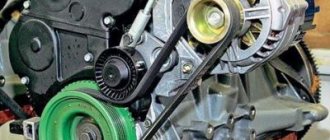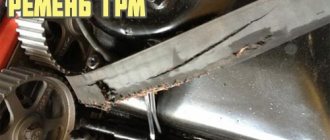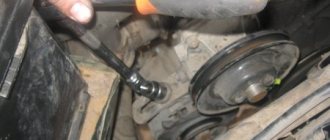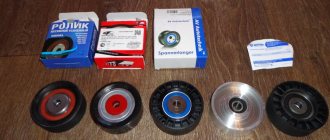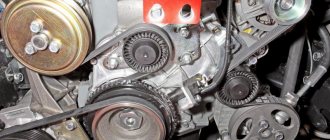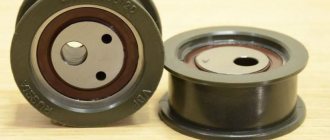The performance of the internal combustion engine depends on the quality of the generator. After the engine starts, the device is the main source of electricity on board the car. However, in order for the rotor to rotate smoothly, it is necessary to properly tension the car’s alternator belt, otherwise problems with current generation will occur.
How to tension a car's alternator belt.
The importance of tension level and checking it
How to tension the alternator belt
Let's consider what unpleasant consequences an incorrect level of tension will lead to. If it is weakened, then there is a high probability of slippage . That is, the generator drive will not operate at rated speed, which in turn will lead to the level of voltage generated by it being below normal. The result is an insufficient level of battery charging, insufficient electricity to power the vehicle systems, and operation of the electrical system under increased load. In addition, when slipping, the temperature of the belt itself increases significantly, that is, it overheats, which is why it loses its service life and may fail prematurely .
If the belt is too tight, this can also lead to excessive wear on the belt itself . And in the worst case, even to its breakage. Also, excessive tension has a detrimental effect on the bearings of the crankshaft and generator shaft, because they have to work under conditions of increased mechanical load. This leads to excessive wear and speeds up their failure.
Video
This video is about tensioning the belt on a Priora.
Another method of tensioning on a Lada Priora.
We found the cause of the belt squeaking to be a misalignment of the tensioner.
Even minor breakdowns in a car can not only ruin your mood, but also cause a so-called chain reaction, when the failure of a secondary component of the car will lead to more significant breakdowns and unplanned expenses. For example, a small unit - a generator belt tensioner, it would seem, what is significant in it? Let's look at how it works, what types of inspection exist and possible repair options.
Tension check
Tension checking process
Now let's look at the issue of checking tension. It’s worth mentioning right away that the force values are unique and depend not only on the make and model of the machine, but also on the generators and belts used. Therefore, look for the relevant information in the manuals for your car or in the operating instructions for the alternator or belt. This will also be influenced by the presence of additional equipment installed in the car - power steering and air conditioning. In general terms, we can say that if you press the belt on the longest section between the pulleys with a force of about 10 kg, then it should deflect by approximately 1 cm (for example, for a VAZ 2115 car, when applying a force of 10 kg, the belt deflection limits are 10 …15 mm for generators 37.3701 and 6…10 mm for generators type 9402.3701).
Often, if the alternator belt is loosely tensioned, it begins to make whistling sounds, and the driver sees malfunctions in the operation of the electrical equipment of the car. In some cases, the low battery light will tell you about problems. In such a situation, we recommend checking the tension level of the alternator belt and increasing it.
If during the check you find that your alternator belt is too loose or too tight, you need to adjust the tension. This can be done in two ways depending on what kind of machine you have - using an adjustment bar or using an adjustment bolt. Let's look at them in order.
Recommendations
- As a rule, the alternator belt must be tightened every 15-20 thousand km. mileage, while the belt is replaced every 60 thousand km. or once every 4-5 years. It is also important to check the tension because the alternator belt stretches over time.
- On some cars you can find an automatic belt tensioner (tension is achieved using springs). In this case, the driver does not have the opportunity to tighten the belt. Only the belt and/or tensioner are replaced as the elements wear out or if the belt slips.
- To replace, you must purchase only high-quality alternator belts, pulleys, bolts and tensioners that are fully suitable for the specific make and model of the car. Ignoring this rule leads to the fact that the belt and tensioning mechanisms can quickly fail, whistles appear, the belt slips or breaks, problems with electrical equipment, etc.
You should be prepared for the fact that if the belt breaks while driving, the power steering may fail. In this case, the effort to turn the wheels on the steering wheel increases significantly (this is especially noticeable at low speeds). For this reason, it is necessary to check the condition of the alternator belt regularly, especially if it also drives the power steering pump on a particular car.We also recommend reading the article about what an EUR is. From this article you will learn how the electric steering differs from the power steering, as well as which type of power steering is better and more reliable.
- After replacing the attachment belt, replacing tensioners and other elements, as well as making adjustments, the tension must be re-checked after a while. The fact is that the new belt may loosen a little after 100-200 km. It also happens that when checking, the belt tension is too strong. However, if the adjustments are not made again, the problem will progress in the case of an insufficiently tensioned belt. If the belt is tightened, this will cause a significant reduction in its service life (by 50-60% or more).
Tension with adjuster bar
Securing the generator using a strip
This method is used for older cars (for example, “classic” VAZs). It is based on the fact that the generator is attached to the engine using a special arc-shaped strip , as well as a bolt and nut. By loosening the fastening, you can move the bar with the generator relative to the engine to the required distance, thereby adjusting the tension level.
Actions are performed according to the following algorithm:
- unscrew the fastening nut on the arc-shaped bar;
- Using a pry bar, we adjust the position (move) of the generator relative to the engine;
- tighten the nut, fixing the new position of the generator.
The procedure is simple, it can be repeated if you were unable to achieve the required level of tension the first time.
Symptoms of tensioner failure
Signs indicating malfunction or wear of the relevant parts:
- no battery charge indicator;
- a whistle or squeak in the area of the working area of the generator belt, appears when it slips in cases where the tension roller is jammed;
- a hum that sounds when a bearing wears out or fails;
- vibration of the belt or roller when the engine is running indicates wear of the bushing, replacement of which is inevitable;
- the amount of belt deflection exceeds one and a half centimeters, which indicates the need for appropriate adjustment;
- free play in the tension pulley or roller indicates that the bearing is worn out;
- one side of the belt is more stretched and worn, a sign of a bend in the tensioner bracket.
Tension using adjusting bolt
Adjustment with a bolt on a VAZ-2110
This method is more progressive and is used in most modern machines. It is based on the use of a special adjusting bolt , by turning which you can adjust the position of the generator relative to the engine. The algorithm of actions in this case will be as follows:
- loosen the generator, its upper and lower fastenings;
- Using the adjusting bolt, we change the position of the generator;
- fix and tighten the generator mount.
The belt tension level in this case can be determined during the adjustment process.
Replacing a worn belt
A brief algorithm of actions when replacing a product:
- The battery in the car is disconnected.
- The car owner loosens the nuts securing the fasteners.
- The tension screw is unscrewed. When performing the task, you must simultaneously press the generator device against the power unit.
- The worn-out product is replaced with a new one. The installed belt is tensioned.
- The nuts are being fixed. A test drive is carried out to check that the tension is correct. If necessary, the product is adjusted.
Tension adjustment using a roller
Adjusting roller and key for it
Some modern machines use special adjustment rollers . They allow you to quickly and easily tension the belt. As an example of using this method, consider adjusting the belt on a Lada Priora car with air conditioning and power steering, as one of the most popular cars in our country.
How to tighten the alternator belt on a Priora
Work on tensioning the alternator belt on a Lada Priora car is carried out using a special tension roller, which is part of the structure. To work, you will need a 17 mm wrench to unscrew and lock the mentioned roller again, as well as a special key to turn the adjusting roller (it is a structure of two rods with a diameter of 4 mm, welded to the base, the distance between the rods is 18 mm). Such a key can be purchased at any auto store for a nominal price. Some car owners use curved pliers or “duckbills” in their work. However, we advise you to still buy an adjustment wrench, given its low price and ease of further work.
Voltage regulation process
To adjust with a 17 key, you need to slightly unscrew the fixing bolt that holds the adjusting roller, then use a special key to turn the roller a little in order to increase (most often) or decrease the belt tension. After this, use the 17 key to fix the adjusting roller again. The procedure is simple and even an inexperienced car owner can handle it. It is only important to choose the right force.
After you have completed the tension, you need to perform a check . To do this, start the engine and turn on the maximum consumers of electricity - high beams, heated rear window, air conditioning. If they work properly and the belt does not whistle, it means you have tensioned correctly.
The automaker recommends tightening the belt every 15 thousand kilometers, and replacing it every 60 thousand. Also, do not forget to periodically check the tension, as the belt tends to stretch.
Alternator belt tension on Priora
Another method for tightening the alternator belt on a Priora
You will find detailed information about the process of replacing the alternator belt on a Lada Priora in the corresponding material.
How to tension the Ford Focus alternator belt
On different modifications of Ford Focus cars, one of two systems for adjusting belt tension is used - using an automatic or using a mechanical roller. In the first case, operation is much simpler for the owner, since the belt is tensioned using built-in springs. Therefore, the driver only needs to periodically replace the belt (either on his own or at a service station).
In the case of a mechanical roller, tension must be done manually using bench tools - a pry bar and wrenches. The design of the roller mechanism may also differ. However, the essence of the procedure comes down to the fact that it is necessary to slightly loosen the fastening of the roller, tighten it and fix it again. Also, in some modifications of the Ford Focus (for example, Ford Focus 3), there is no tension adjustment . That is, if the belt slips, it must be replaced.
Note! Buy original belts, as often non-original ones are slightly larger, which is why it will whistle and get hot after installation.
We invite you to familiarize yourself with the material, which presents the procedure for replacing the alternator belt on a Ford Focus 2 car - article.
Generator drive device
The main condition for the correct functioning of the generator is the correct transmission of rotation from the power plant. To generate the required amount of electricity, the element must rotate at high speed.
The alternator drive belt must be tensioned for proper transmission. If the belt sag, it will begin to slip on the pulleys. If the belt is overtightened, there is a risk of premature wear of the bearings, working surfaces of the pulley and belt.
To avoid these troubles, belt tension adjustment was included in the design.
In modern cars the number of attachments is large. This equipment is also driven by the crankshaft pulley, including the power steering pump and air conditioning compressor.
The drive of these two units and the generator is carried out using a single belt. Because of this, it is impossible to adjust the tension of the drive element using a generator. Such cars have a complex belt position configuration. Belt-driven equipment is located at different levels.
How to change the alternator belt tensioner pulley? To do this, you need to understand its structure. The generator belt tensioner roller is a bearing with a plastic lining on its outer race. The pad has a working surface along which the belt moves. There is a landing sleeve inside the roller. There are two types of rollers:
- Eccentric . The design of this video is quite simple. It contains only a bearing, a plastic lining and a bushing. A through hole passes through the bushing, offset away from the center of the roller. The roller is put on a pin through the hole, which is installed on the engine. To tighten, the roller must be rotated relative to the bolt.
- Roller with bracket . In this design, the roller is fixedly mounted on a bracket. The structure is attached to the power plant using bolts. Moving the bracket relative to the engine adjusts the tension. Manufacturers sometimes use rollers with a spring bracket. The spring allows you to independently adjust the tension.
The bearing is the main weak point of the roller. This part is forced to constantly experience loads. Wear of a part sometimes even ends in its complete breakdown.
It is recommended to change the bearing every time the belt is replaced.
Finally
Regardless of which method you used to adjust the position of the generator, after the procedure you need to turn the crankshaft 2-3 times using a wrench, and then make sure that the tension level of the hanging belt has not changed. We also recommend driving a short distance (1…2 km), and then checking again .
If you have not found information about the tension level of the alternator belt or cannot perform this procedure yourself, contact a service station for help. If the adjusting mechanisms are set to the extreme position and the belt tension is insufficient, this indicates that it needs to be replaced. As a rule, the mileage of a car between belt replacements is 50...80 thousand kilometers, depending on the model and brand of the car, as well as on the material from which the belt is made.
What happens if you drag
Not all motorists know what will happen if drivers overtighten the belt during tensioning. Increased load increases wear on the unit. It manifests itself in the form of a characteristic hum from an electrical appliance. The main noise comes from bearings and rollers, which will create increased tension. Due to pinching, it will be more expensive to repair the water pump or air conditioning compressor involved in the circuit. It is worth paying attention to the special marks used by manufacturers to monitor tensioner wear and timely replacement of the belt.
